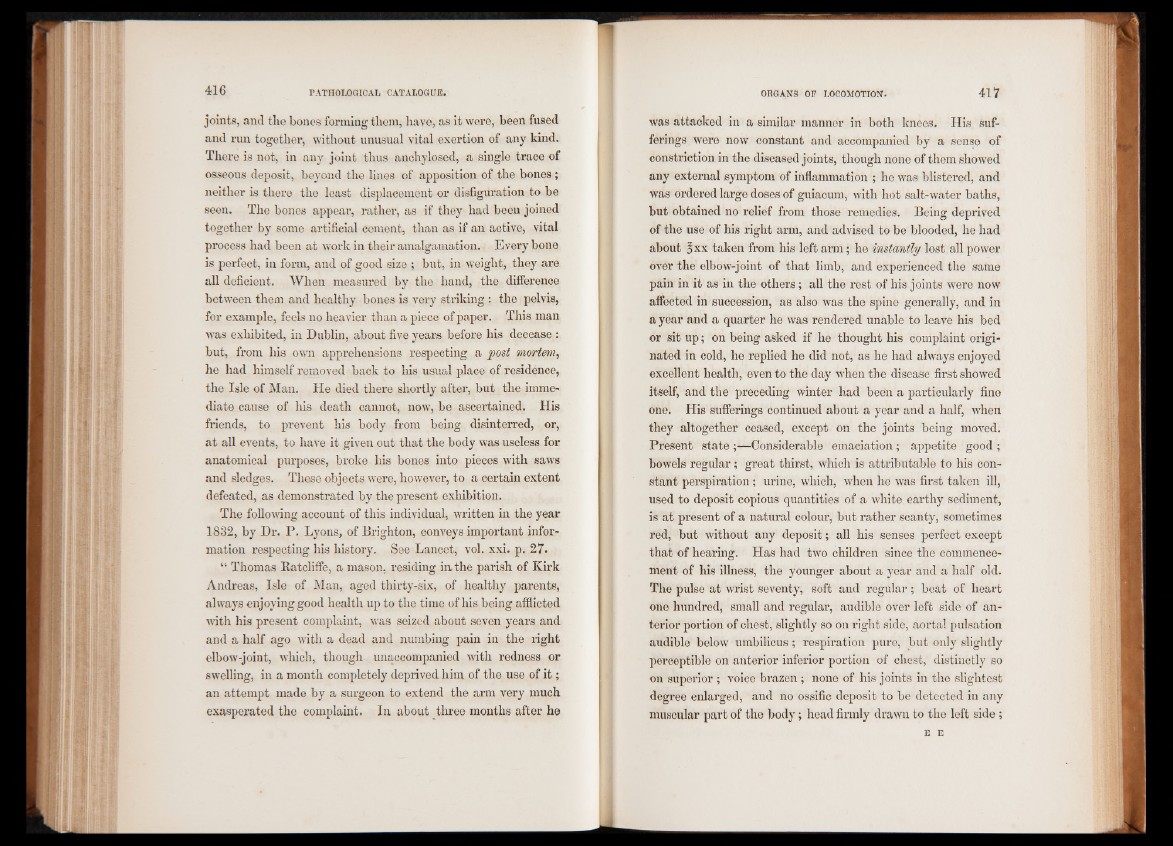
joints, and the bones forming them, have, as it were, been fused
and run together, without unusual vital exertion of any kind.
There is not, in any joint thus anchylosed, a single trace of
osseous deposit, beyond the lines of apposition of the bones;
neither is there the least displacement or disfiguration to be
seen. The bones appear, rather, as if they had been joined
together by some artificial cement, than as if an active, vital
process had been at work in their amalgamation. Every bone
is perfect, in form, and of good size ; but, in weight, they are
all deficient. When measured by the hand, the difference
between them and healthy bones is very striking : the pelvis,
for example, feels no heavier than a piece of paper. This man
was exhibited, in Dublin, about five years before his decease :
but, from his own apprehensions respecting a post mortem,
he had himself removed back to his usual place of residence,
the Isle of Man. He died there shortly after, but the immediate
cause of his death cannot, now, be ascertained. His
friends, to prevent his body from being disinterred, or,
at all events, to have it given out that the body was useless for
anatomical purposes, broke his bones into pieces with saws
and sledges. These objects were, however, to a certain extent
defeated, as demonstrated by the present exhibition.
The following account of this individual, written in the year
1832, by Dr. P. Lyons, of Brighton, conveys important information
respecting his history. See Lancet, vol. xxi. p. 27.
“ Thomas Ratcliffe, a mason, residing in. the parish of Kirk
Andreas, Isle of Man, aged thirty-six, of healthy parents,
always enjoying good health up to the time of his being afflicted
with his present complaint, was seized about seven years and
and a half ago with a dead and numbing pain in the right
elbow-joint, which, though unaccompanied with redness or
swelling, in a month completely deprived him of the use of it ;
an attempt made by a surgeon to extend the arm very much
exasperated the complaint. In about three months after he
was attacked in a similar manner in both knees. His sufferings
were now constant and accompanied by a sense of
constriction in the diseased joints, though none of them showed
any external symptom of inflammation ; he was blistered, and
was ordered large doses of guiacum, with hot salt-water baths,
but obtained no relief from those remedies. Being deprived
of the use of his right arm, and advised to be blooded, he had
about 3 xx taken from his left arm; he instantly lost all power
over the elbow-joint of that limb, and experienced the same
pain in it as in the others; all the rest of his joints were now
affected in succession, as also was the spine generally, and in
a year and a quarter he was rendered unable to leave his bed
or sit up; on being asked if he thought his complaint originated
in cold, he replied he did not, as he had always enjoyed
excellent health, even to the day when the disease first showed
itself, and the preceding winter had been a particularly fine
one. His sufferings continued about a year and a half, when
they altogether ceased, except on the joints being moved.
Present state ;—Considerable emaciation; appetite good ;
bowels regular; great thirst, which is attributable to his constant
perspiration; urine, which, when he was first taken ill,
used to deposit copious quantities of a white earthy sediment,
is at present of a natural colour, but rather scanty, sometimes
red, but without any deposit; all his senses perfect except
that of hearing. Has had two children since the commencement
of his illness, the younger about a year and a half old.
The pulse at wrist seventy, soft and regular; beat of heart
one hundred, small and regular, audible over left side of anterior
portion of chest, slightly so on right side, aortal pulsation
audible below umbilicus; respiration pure, but only slightly
perceptible on anterior inferior portion of chest, distinctly so
on superior ; voice brazen ; none of his joints in the slightest
degree enlarged, and no ossific deposit to be detected in any
muscular part of the body; head firmly drawn to the left side;
E E